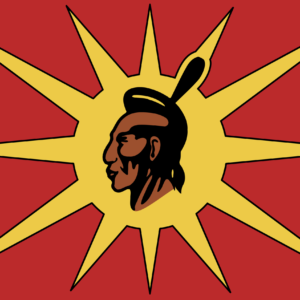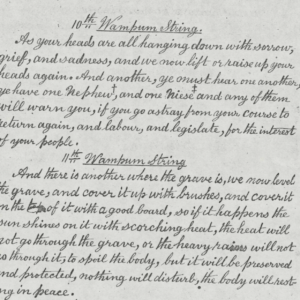
Anthropology is one of the most boring words in the world but simply put, it means the study of human beings and their ancestors. Indigenous people around the world get a little sick of these scientists because they have retold our stories wrong a few times here and there. Even worse, some have exploited our culture like vultures.
Usually these studies are loosely based around migration theories to prove that we too, are merely visitors to this land — which is why some of my relations are deeply offended by the term ‘First Nations of Canada’.
On Six Nations we say that we are Onkwehon:weh, which means ‘real people’ in our language.
Sadly, the scientific community has been studying and proliferating the wrong subject matter.
Ask an average Canadian to come up with some positive stereotypes of indigenous people and you will see where the establishment has failed us. The best that a class full of students at Western could come up with was the loyal native stereotype, or the resourceful native — as if we were the original MacGyver.
If the anthropologists had been on the ball, the world would now also be familiar with the hilarious native.
Throughout our greatest accomplishments: Incan/Mayan Pyramids, implementing the Great Peace, invention of Lacrosse, Indian Tacos, and surviving colonialism, there have no doubt been little jokesters snickering and commenting amongst themselves. It’s a staple of our egalitarian society — a horizontal class structure guarantees the odd gag at someones expense. Plus, we were all family then.
Disease and colonialism brought our once mighty nations to their knees, but we even found humour in that somehow. Maybe it’s called ‘dark humour’ but all along there has been some natives doing silly stuff in the background making jokes while havoc and devastation was breaking out all around them.
This untold indigenous narrative is still happening in the background of colonialism today like a 500-year-old Monty Python skit. We sometimes think our bossy and semi-murderous visitors are funny (see! that was indigenous humour right there).
Eleanor Esquimaux, a Shingwauk residential school survivor, spoke about how her and her many sisters were often reprimanded for giggling during super important Anglican ceremonies and services. She said that when they got together, “everything was funny”.
Elle was stereotypically loyal. Eleanor was also resourceful, but I mostly remember her silly sense of humour because she was my mom. If you had met her you wouldn’t know she was a survivor of cultural genocide. Fifty years later, Eleanor and my Potawotami aunties would still cause a riot of laughter when they sat down together at a table. Eleanor Garlow passed away in 2009 at the age of 65 and has been deeply missed.
Meanwhile in the academic world, to get anything accomplished we have to do it ourselves.
Author of Custer Died for Your Sins, the late Vine Deloria Jr., wrote an acute assessment of our jovial condition. He was surprised that we actually accomplished anything as a society — not because we were brain dead savages, but because we placed an overemphasis on micro-comedy across the board.
“(Indians) have found a humorous side to nearly every problem and the experiences of life have been so well defined through jokes and stories that they have become a thing in themselves. The more desperate the problem, the more humour is directed to describe it.” Deloria wrote in his 1969 work.
Even though we don’t identify by “Indian” anymore, we can still find the humour in it all. Look at the viral popularity of the “Caucasians” T-shirt that spoofs the racist Cleveland Indians mascot “Chief Wahoo.” This shirt was most famously worn by Bomani Jones on ESPN.
“The great capacity of (Indian) people for creative wit has been obscured by the image of the (Indian) as silent stoic,” wrote Don Fixico, Professor of History at Arizona State University (2006).
We have a chronicled history of comedy that goes way back.
This is kind of comical in itself but in the year 1635 A.D. a Dutch barber-surgeon named Harmen Meyndertsz van den Bogaert undertook a voyage into Mohawk Country and kept a journal of his experiences.
Bogaert had been journeying by foot from Manhattan to the Finger Lakes region for a fortnight and was approaching what he called a “castle” which we can think of as an indigenous walled community.
He wrote, “A lone woman brought us some baked pumpkins … as we entered the Indians divided themselves into two rows and let us pass between them through their entrance.”.
They spent the night at Castle Onneyuttehage, which was built upon a very high hill, was 767 steps in circumference, and had 66 houses inside the double rowed palisades.
“An (Indian) once again called us scoundrels … he was very malicious so that Willem Tomassen became so angry that the tears ran from his eyes. The (Indian) seeing that we were upset, asked us why we looked at him with such anger. We were sitting during this time with their 46 persons around and near us. Had they any malicious intentions, they could have easily grabbed us with their hands and killed us without much trouble. However, when I had heard his screaming long enough, I told him that he was the scoundrel. He began to laugh and said, “You must not be angry. We are happy that you have come here.””.
This brave adventurer then became an instant brother. The book is available on amazon.
If you are new to reservation life, a good sign that the locals like you is if they tease you or if they give you a nickname. Embrace it.
If you live on Six Nations, just think of those nicknames of all the people you know. Sometimes we identify with our nicknames more than our ‘government name’. Some people have funny names and you don’t even know their proper name so it makes it awkward when you shout, “Sago Dumpy!” at Zehrs in front of all kinds of Canadian people.
The problem is that colonialism tainted and corrupted our original nature and what would have been culturally appropriate teasing has now degenerated into bullying and lateral violence. Residential school taught our people to hurt one another — and we are still recovering from that, plain and simple.
“Humour was supposed to be the 8th grandfather teaching, but that grandfather got kicked out because he was always making jokes,” said the indigenous teacher and guru Giibwanisi Dizhnikaaz Mkwa Dodem. Giibwanisi speaks a humorous, giggley, cadence, always on the edge of laughter as he teases his friends. Giibwanisi also makes semi-disrespectful memes of me, publisher Jonathan Garlow, and shares them on the internet.
It’s like an indigenous roast, and it feels good.
In the academic world this cultural teasing is called “permitted disrespect” and requires a relationship of intimacy and trust — something we are in short supply of these days.
Anishnaabe World a book by Canadian author Roger Speilmann has a chapter titled Native Humour and Why Canadians Often Don’t Seem to “Get It”. This author is also an Associate Professor of Native Studies at the University of Sudbury and he wrote that “teasing differs” between indigenous people and non-indigenous people.
Growing up on Six Nations I would have to agree with Mr. Speilmann.
So as a rule of thumb, we need to become brave enough to tell our friends and family when a name or comment hurts our feelings and negatively affects us. Let’s all agree to be sensitive enough to respond appropriately when our behaviour is corrected.
This is the whole point of Good Minds Stand Up project — we want to get back to a society of unique personalities co-existing together in harmony.
Bless up.






